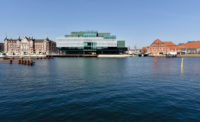Solar Carve by Studio Gang
New York

Photo © Nic Lehoux

Solar Carve’s design uses incident angles of the sun’s rays to sculpt its form.
Photo © Nic Lehoux

The carved curtain wall mitigates glare and heat gain and also creates dynamic corner work spaces.
Photo © Tom Harris

Image courtesy Studio Gang

Image courtesy Studio Gang

Image courtesy Studio Gang






Architects & Firms
“We wanted to show how a building could be a good neighbor,” Jeanne Gang tells RECORD of her firm’s new speculative office building beside the High Line in New York, 40 Tenth Avenue, also called Solar Carve. The Studio Gang founding principal admits to being “shocked” at what zoning would have allowed them to erect at the site. The parcel is situated in an already densely built section of the High Line, at the corner of 14th Street facing the busy West Side Highway in one direction and two other buildings—including the broad, 18-story Standard Hotel—that straddle the elevated park in the other. “If we were to have built our building as of right, it would have shaded the gardens and killed all the plants that were already there,” says Gang.
Additional Content:
Jump to credits & specifications
Instead, the firm undertook a lengthy approvals process to build a taller, more slender tower that did not conform to the standard zoning envelope. The code did not require any setbacks, aside from a 5-foot gap from the former rail structure. But Studio Gang shaped its 11-story tower, which is targeting LEED Gold certification, in response to solar access, working with consultant Arup on the carving scheme to produce a narrow L-shaped volume that angles back at two corners with striking faceted facades—the northwest corner toward the highway, the southeast one overlooking the High Line, but separated from it by a large terrace. Along the rest of the length of the building, 16-foot-tall flat glass panels span the full floor-to-ceiling height, creating brightly daylit office spaces. (The off-axis elevator core is tucked into the darkest part of the parcel, allowing open floors that can flexibly accommodate various work spaces.)
It’s a design strategy Studio Gang has used before. In Solstice on the Park, a 26-story residential tower in Chicago, completed last year, recessed windows along the south facade are slanted 72 degrees according to optimal sun angles, maximizing sunlight in winter for passive solar warming and minimizing heat gain during summer. “In that building, we calibrated angles according to the scale of the units,” explains Wes Walker, design principal and partner in charge of Studio Gang’s nearly 40-person New York office. “At Solar Carve, it was done according to the scale of the entire height of the tower.”
As opposed to the sun-loving perennials just south of it, the plantings beside Solar Carve include shade-tolerant grasses, perennials, and woody species because of the existing surrounding buildings. Studio Gang’s move nevertheless triples the amount of sunlight to that area compared to the canyonlike esplanade that would have resulted with an as-of-right building along the High Line. In addition to being friendly to plants, the move takes into consideration birds migrating along the Hudson River, drivers on the West Side Highway, and visitors to the elevated park.
The building’s high-performance glass is fritted in certain areas where needed to help avoid bird collisions—something Studio Gang is working with the Audubon Society to monitor. The low-reflectivity glazing reduces the glare typical of shiny office buildings that often distracts drivers. For those walking along the High Line, the angled- back design—formed by staggered, prefabricated, three-dimensional glazing units integrating a diamond-shaped panel surrounded by triangular ones—opens up views toward the Hudson.
The solar carving of the facade does one more thing. During a tour of the building with Studio Gang project leader Bryan Scheib late one afternoon in November, the west-facing corner lit up to a golden hue all along its length. Declared Scheib, “That’s the Stonehenge moment.”
CreditsArchitect: Studio Gang
Engineering: Arup (structural, facade, acoustical, daylighting); RA Engineering (geotechnical); GEA Consulting Engineers (m/e/p, sustainability, IT, security)
Consultants: HMWhite (landscape); Fisher Marantz Stone (lighting)
General contractor: Cauldwell Wingate
Client: Aurora Capital Associates and William Gottlieb Real Estate
Size: 145,500 square feet
Cost: withheld
Completion date: July 2019 |
SpecificationsGlass Interpane
Curtain wall Focchi
Entrances Kawneer, Focchi
Acoustical ceilings Armstrong
Masonry Rieder
Special surfacing Amuneal Metals, McGrory Glass, Get Real Surfaces |











